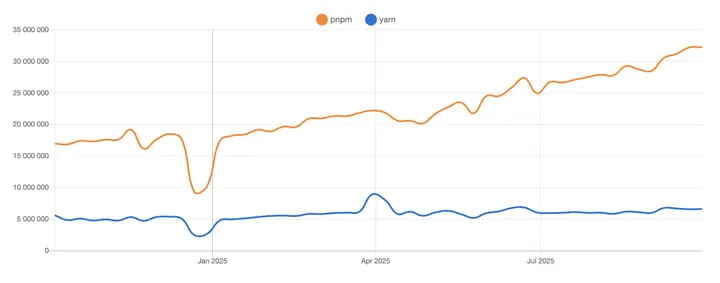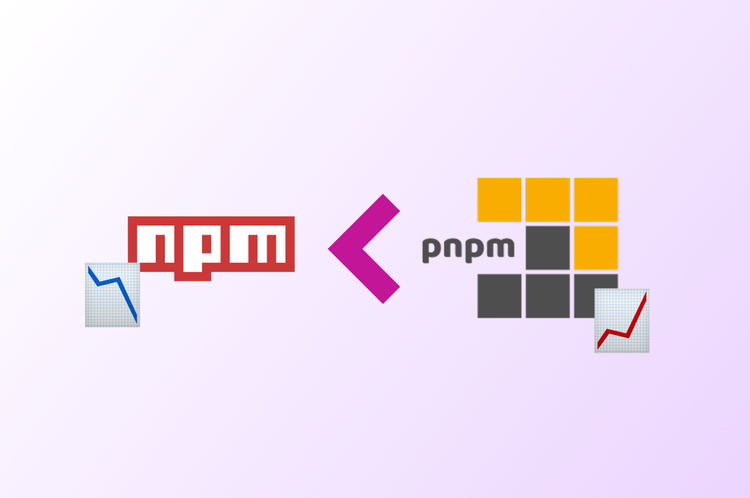The Developer Reality Check
Does your team have multiple similar projects where running npm install means it’s coffee ☕️ break time? Is your CI/CD pipeline generating costs and you’re looking for ways to save money?
If you answered yes to either question, keep reading.
Most developers are stuck using npm while a mature, battle-tested solution could cut their installation times by 70% and reduce CI costs significantly. That solution is pnpm – and no, it’s not “just another Yarn.”
Your Daily Pain Points, Measured: pnpm Performance Benchmarks
Let’s put some numbers to those frustrations. Here’s what the performance difference looks like in real scenarios:
Developer Scenario (with cache, with lockfile): When a repo is fetched by a developer and installation is first run
npm: 9.2 secondspnpm: 2.5 seconds
CI Pipeline Scenario (with lockfile): When an installation runs on a CI server
npm: 12.6 secondspnpm: 6.5 seconds per build
The Scale Effect:
For CI build optimization, a team building a large application with 10 daily deployments across 3 environments (dev/staging/prod), that’s 30 CI builds daily. With npm, you’re spending 378 seconds (6.3 minutes) on package installation. With pnpm, that drops to 195 seconds (3.25 minutes) – saving over 3 minutes of compute time daily.
Scale that to a month: npm uses 189 minutes of CI time just for package installation, while pnpm uses only 97.5 minutes. That’s 1.5+ hour of compute savings monthly and you can save even more if you configure cache correctly in your pipeline.
For developers, 9.2s vs 2.5s is the difference between losing your mental context and staying focused when you switch branches or pull updates.
| Scenario | npm | pnpm |
|---|---|---|
| Developer first install | 9.2s | 2.5s (-73%) |
| CI server build | 12.6s | 6.5s (-48%) |
Source: pnpm benchmarks
This Isn’t Just Another Yarn
”Oh great, another package manager. Let me guess, it’s slightly faster and has a different lockfile format?”
If that’s your reaction, you’re not alone. Many developers dismiss pnpm as “just another Yarn” – another attempt to reinvent npm with marginal improvements. But both Yarn Berry (with PnP) and pnpm represent fundamental departures from npm’s approach, each solving dependency management problems in different ways.
Three Different Philosophies:
npm: Traditional flat node_modules structure. Simple, well-understood, but inefficient.
Yarn Berry (PnP): Eliminates node_modules entirely, stores packages in zip files with runtime resolution via pnp.cjs. Extremely fast and space-efficient, but requires ecosystem adaptation.
pnpm: Uses symlinks to create a centralized store while maintaining a real node_modules structure. Balances efficiency with full Node.js compatibility.
Where pnpm Stands Out:
- Full Node.js Compatibility: Works with every tool without configuration or patches
- Transparent Debugging: Dependencies are physical files, not hidden in zip archives
- Phantom Dependency Prevention: Strict
node_modulesprevents accessing unlisted dependencies - Global Store Efficiency: One copy of each package version across all projects
- Ecosystem Neutrality: Doesn’t require runtime hooks or ecosystem changes
- Conceptual Simplicity: The symlink approach is intuitive – packages stored once, linked everywhere. Easy to understand and reason about.
The Trade-offs: Yarn Berry can be faster in some scenarios, but requires tools to support PnP mode and its zip-based approach can be complex to debug. pnpm sacrifices some theoretical efficiency for universal compatibility and conceptual clarity – you get most of the benefits without breaking existing workflows or mental models.
The Technology Behind the Magic: pnpm Hard links & Symlinks Explained
Here’s how pnpm actually works under the hood.
Understanding Symlinks and Hard Links
Before diving into pnpm’s architecture, let’s understand the core concepts:
- Symlink (symbolic link): Think of it as a shortcut or pointer to another file/folder on your computer. The actual files stay in one place, but you can access them from multiple locations.
- Hard link: Multiple references to the same physical file on disk. Unlike symlinks, all references are equal – there’s no “original” and “copy.”
Centralized Package Storage (pnpm store)
Instead of duplicating packages across every project, pnpm stores each package version exactly once in a global store. When you install a package, pnpm creates hard links from this central location to your project.
# Traditional npm approach:
project-1/node_modules/react/ (50MB of React files)
project-2/node_modules/react/ (50MB of the SAME React files)
project-3/node_modules/react/ (50MB of the SAME React files)
Total: 150MB for the same package!
# pnpm approach:
/some-os-path/pnpm/store/react@18.2.0/ (50MB - stored once)
project-1/node_modules/react/ (symlink → points to store)
project-2/node_modules/react/ (symlink → points to store)
project-3/node_modules/react/ (symlink → points to store)
Total: 50MB, no matter how many projects use React!
The Magic: If you have 10 projects using React 18.2.0, the files exist on disk exactly once, not 10 times. Massive disk space savings when you work on multiple projects.
Strict node_modules Structure
Unlike npm’s flat structure, pnpm only puts your direct dependencies in the top-level node_modules. Transitive dependencies are stored in the nested .pnpm directory and accessed through symlinks.
# npm structure (flat - can access anything)
node_modules/
├── react/
├── react-dom/
├── scheduler/ # transitive dependency of react
└── loose-envify/ # you can import this even if not in package.json
# pnpm structure (strict - only direct dependencies visible)
node_modules/
├── react/ # symlink to .pnpm/react@18.2.0/node_modules/react
├── react-dom/ # symlink to .pnpm/react-dom@18.2.0/node_modules/react-dom
└── .pnpm/
├── react@18.2.0/node_modules/react/
├── scheduler@0.23.0/node_modules/scheduler/
└── loose-envify@1.4.0/node_modules/loose-envify/
Why This Matters: This prevents “phantom dependencies” – bugs where your code works locally because npm flattened a transitive dependency to the top level, but breaks in production or on teammates’ machines.
The Results:
- Disk space savings: Across multiple projects, you save gigabytes of storage
- Faster installations: No need to copy the same files multiple times
- More reliable builds: Strict dependency resolution catches issues npm misses
- Consistent environments: Same dependency tree in development and production
pnpm Is Production-Ready
Still worried about adopting a “newer” package manager? Major frameworks and tools already rely on pnpm as their default choice.
Framework Integration:
Vue.js development uses pnpm by default. SvelteKit powers its build toolchain with pnpm. Vite, the fastest build tool in the ecosystem, uses pnpm for package management. Shopify’s Hydrogen templates come with pnpm configuration out of the box.
Community Momentum - developers in the 2024 State of JS survey chose pnpm as the best monorepo tool.
- 93% satisfaction rate among developers who tried pnpm
- 42% already using it in production
- 85% awareness in the developer community
- 62% interest from developers who haven’t tried it yet
The adoption trend is clear when looking at download statistics - pnpm’s community is growing significantly faster than Yarn’s, reflecting developers’ preference for its balanced approach to dependency management (Source: npm trends).

Weekly downloads from the past year show pnpm’s steady growth compared to Yarn.
That’s not early-adopter territory – that’s mainstream adoption.
Real-World Reliability: I’ve been using pnpm in practically all commercial projects since 2022, and it has never let me down. Zero compatibility issues, consistent performance, and seamless team adoption across different project types.
Monorepo Support: Beyond being a package manager, pnpm is also a powerful monorepo tool that allows you to manage multiple related applications in a single repository with workspace configurations, shared dependencies, and efficient cross-project dependency management.
The evidence is clear: pnpm has moved from “interesting alternative” to “production standard” for performance-conscious teams.
Addressing Developer Concerns
Let’s tackle the practical worries that prevent teams from making the switch.
”What if I have multiple projects with different package managers?”
Corepack solves version management elegantly. It automatically detects and uses the correct package manager version specified in each project’s package.json:
# For new projects, install the correct version first
corepack install
# Then enable automatic version management
corepack enable
# Now each project uses its specified package manager automatically
Corepack reads the packageManager field and handles switching between npm, yarn, and pnpm versions without any manual intervention.
”How do I enforce pnpm usage in my team/repo?”
Add the packageManager field to your package.json:
{
"packageManager": "pnpm@10.18.1"
}
With Corepack enabled, the project automatically uses the specified pnpm version, and team members can’t accidentally use the wrong package manager.
”What about CI/CD compatibility?”
Most CI providers work seamlessly with Corepack:
# [GitHub Actions](https://github.com/features/actions)
- run: npm install -g corepack@latest
- run: corepack enable
- run: pnpm install
“Will my existing tools work?”
Yes. pnpm creates a real node_modules structure, so every tool that works with npm works with pnpm. No special configuration needed.
Making the Switch is Easier Than You Think: Complete pnpm Migration Guide
Ready to experience those 70% faster installations? Here’s how to get started without breaking anything.
For New Projects
Here’s how to set up pnpm for new projects with Corepack:
# Set up Corepack (one-time setup)
npm install -g corepack@latest
corepack enable
# Create new project with pnpm
corepack install
pnpm init
pnpm add your-dependencies
For Existing Projects
Here’s how to migrate from npm to pnpm in three simple commands:
# Import your existing lockfile
pnpm import
# This converts package-lock.json to pnpm-lock.yaml automatically
# Your dependencies stay exactly the same
Team Adoption Strategy:
- Start small: Try pnpm on your next new project
- Configure enforcement: Add
"packageManager": "pnpm@10.18.1"to package.json - Gradual migration: Convert existing projects one at a time using
pnpm import
The learning curve is minimal – if you know npm commands, you know pnpm commands. The performance gains start immediately.
Summary
We’ve covered why pnpm should replace npm in your workflow:
- 70% faster installations with concrete time savings that add up across your team
- Fundamental architectural advantages through hard links, symlinks and centralized storage
- Built-in monorepo support for managing multiple related applications with workspace configurations
- Easy migration path with
pnpm importand Corepack for version management
Among all node package manager alternatives, pnpm isn’t just another package manager – it’s a logical evolution that solves real problems while maintaining full compatibility with the Node.js ecosystem.
Try it on your next project – you’ll never go back.
